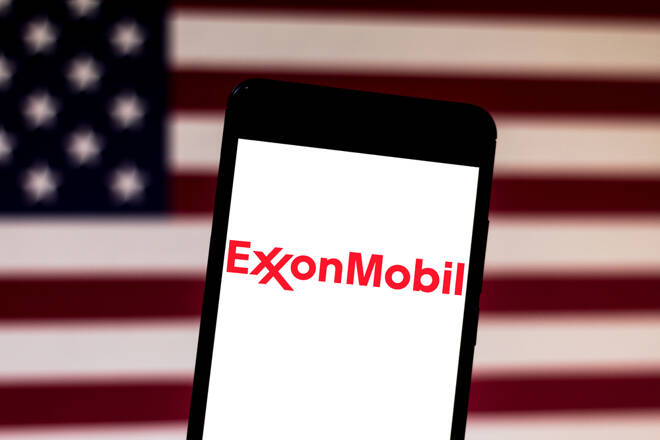Advertisement
Advertisement
Exxon Mobil Expects Bigger Q3 Loss, But Recovery in Chemicals Industry Would Benefit; Target Price $43
By:
Exxon Mobil Corp, an American multinational oil and gas entity headquartered in Texas, said on Thursday that its third-quarter result could slip into larger-than-anticipated loss as the company continues to struggle from the pandemic-driven slowdown.
Exxon Mobil Corp, an American multinational oil and gas entity headquartered in Texas, said on Thursday that its third-quarter result could slip into larger-than-anticipated loss as the company continues to struggle from the pandemic-driven slowdown.
“From 2015-18 chemicals represented 25% of XOM’s earnings, the largest of the global oil majors. However, a collapse in industry margins drove an 85% reduction in segment earnings in 2019 vs. 2015-18 avg. Now, a global petchem recovery could drive a needed uplift to earnings and cash flow,” said Devin McDermott, equity analyst and commodities strategist at Morgan Stanley.
Exxon Mobil’s shares closed 2.30% higher at $33.74 on Monday; however, the stock is down about 60% so far this year.
The company said in a filing that higher oil prices would help exploration and production earnings by $1.4 billion to $1.8 billion, compared with the second quarter, But subdued gas prices will continue to weigh on the segment and could hurt earnings by as much as $500 million, Reuters reported.
Exxon Mobil will report its Q3 results on October 30.
U.S. oil giant Exxon Mobil said on Monday that as part of an extensive global review outlined during ExxonMobil’s second-quarter earnings call, the company plans to reduce staffing levels across a number of its European affiliates.
“While Exxon Mobil (XOM) would benefit from an uplift in chemicals margins, we expect low oil & gas prices and refining crack spreads to weigh on future cash flow and earnings. Despite increasing our 2021/22 EPS, we remain 50% below consensus in both years. Though management is committed to sustaining the dividend, we estimate the coverage of only 55% in 2021 and 35% in 2022, driving leverage higher despite an improvement in chemicals margins,” McDermott added.
“We estimate net debt to capital will increase to 28% by the end of 2021 and 32% by year-end 2022. Further, we believe that capex will ultimately need to increase from the 4Q20 anticipated run-rate of $19B toward $25B or higher to stabilize the business. During our recent conversation with the company, XOM outlined further opex and capex cuts as tools to limit the strain on the balance sheet and preserve the dividend.”
Exxon Mobil stock forecast
Eleven analysts forecast the average price in 12 months at $43.78 with a high forecast of $55.00 and a low forecast of $33.00. The average price target represents a 29.76% increase from the last price of $33.74. From those 11, two analysts rated ‘Buy’, seven analysts rated ‘Hold’ and two rated ‘Sell’, according to Tipranks.
Morgan Stanley target price is $46 with a high of $85 under a bull scenario and $23 under the worst-case scenario. Citigroup lowered their price target to $33 from $42; JP Morgan cuts target price to $37 from $51; Scotiabank slashed their price target to $45 from $47 and Wells Fargo cuts price target to $43 from $46.
Several other analysts also recently issued reports on the company. Exxon Mobil had its price objective upped by Royal Bank of Canada from $45 to $50. The firm currently has an underperform rating on the oil and gas company’s stock. MKM Partners initiates with buy rating and $55 price target. Independent Research cuts target price to $ 42 from $47; rating hold. HSBC raised the target price to $48 from $47.5.
Analyst comment
“Attractive investment opportunities, but above average execution risk. XOM reduced its 20/21 capex plans, deferring but not abandoning its counter-cyclical growth strategy. Capex ultimately needs to move higher to stabilize the business, and while XOM does have high-quality investment opportunities, funding the capital program and the dividend will strain the balance sheet absent higher commodity prices, making dividend sustainability a lingering risk,” said Devin McDermott, equity analyst and commodities strategist at Morgan Stanley.
“High capex limits FCF. Higher spending and more exposure than peers to current downstream & chemicals margin weakness leads to lower FCF yield. Earnings growth targets appear hard to achieve with current downstream & chemicals margins,” he added.
Upside and Downside Risks
Upside: 1) Higher commodity prices, including liquefied natural gas (LNG). 2) Successful execution of major capital projects. 3) Permian well performance improvements- highlighted by Morgan Stanley.
Downside: 1) Lower commodity prices. 2) Cost overruns on major capital projects. 3) Service cost inflation in the Permian erodes returns. 4) Geopolitical risk could impact production volumes and/or returns; Guyana is a particular focus now.
About the Author
Vivek Kumarauthor
Vivek completed his education from the University of Mumbai in Economics and possesses stronghold in writing on stocks, commodities, foreign exchange, and bonds.
Advertisement
